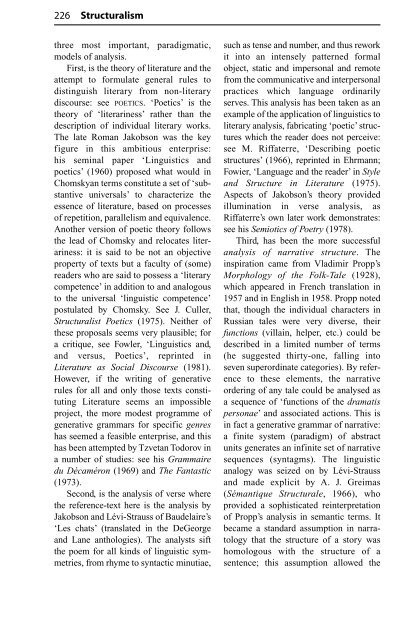The Routledge Dictionary of Literary Terms
The Routledge Dictionary of Literary Terms
The Routledge Dictionary of Literary Terms
Create successful ePaper yourself
Turn your PDF publications into a flip-book with our unique Google optimized e-Paper software.
226 Structuralism<br />
three most important, paradigmatic,<br />
models <strong>of</strong> analysis.<br />
First, is the theory <strong>of</strong> literature and the<br />
attempt to formulate general rules to<br />
distinguish literary from non-literary<br />
discourse: see POETICS. ‘Poetics’ is the<br />
theory <strong>of</strong> ‘literariness’ rather than the<br />
description <strong>of</strong> individual literary works.<br />
<strong>The</strong> late Roman Jakobson was the key<br />
figure in this ambitious enterprise:<br />
his seminal paper ‘Linguistics and<br />
poetics’ (1960) proposed what would in<br />
Chomskyan terms constitute a set <strong>of</strong> ‘substantive<br />
universals’ to characterize the<br />
essence <strong>of</strong> literature, based on processes<br />
<strong>of</strong> repetition, parallelism and equivalence.<br />
Another version <strong>of</strong> poetic theory follows<br />
the lead <strong>of</strong> Chomsky and relocates literariness:<br />
it is said to be not an objective<br />
property <strong>of</strong> texts but a faculty <strong>of</strong> (some)<br />
readers who are said to possess a ‘literary<br />
competence’ in addition to and analogous<br />
to the universal ‘linguistic competence’<br />
postulated by Chomsky. See J. Culler,<br />
Structuralist Poetics (1975). Neither <strong>of</strong><br />
these proposals seems very plausible; for<br />
a critique, see Fowler, ‘Linguistics and,<br />
and versus, Poetics’, reprinted in<br />
Literature as Social Discourse (1981).<br />
However, if the writing <strong>of</strong> generative<br />
rules for all and only those texts constituting<br />
Literature seems an impossible<br />
project, the more modest programme <strong>of</strong><br />
generative grammars for specific genres<br />
has seemed a feasible enterprise, and this<br />
has been attempted by Tzvetan Todorov in<br />
a number <strong>of</strong> studies: see his Grammaire<br />
du Décaméron (1969) and <strong>The</strong> Fantastic<br />
(1973).<br />
Second, is the analysis <strong>of</strong> verse where<br />
the reference-text here is the analysis by<br />
Jakobson and Lévi-Strauss <strong>of</strong> Baudelaire’s<br />
‘Les chats’ (translated in the DeGeorge<br />
and Lane anthologies). <strong>The</strong> analysts sift<br />
the poem for all kinds <strong>of</strong> linguistic symmetries,<br />
from rhyme to syntactic minutiae,<br />
such as tense and number, and thus rework<br />
it into an intensely patterned formal<br />
object, static and impersonal and remote<br />
from the communicative and interpersonal<br />
practices which language ordinarily<br />
serves. This analysis has been taken as an<br />
example <strong>of</strong> the application <strong>of</strong> linguistics to<br />
literary analysis, fabricating ‘poetic’ structures<br />
which the reader does not perceive:<br />
see M. Riffaterre, ‘Describing poetic<br />
structures’ (1966), reprinted in Ehrmann;<br />
Fowier, ‘Language and the reader’ in Style<br />
and Structure in Literature (1975).<br />
Aspects <strong>of</strong> Jakobson’s theory provided<br />
illumination in verse analysis, as<br />
Riffaterre’s own later work demonstrates:<br />
see his Semiotics <strong>of</strong> Poetry (1978).<br />
Third, has been the more successful<br />
analysis <strong>of</strong> narrative structure. <strong>The</strong><br />
inspiration came from Vladimir Propp’s<br />
Morphology <strong>of</strong> the Folk-Tale (1928),<br />
which appeared in French translation in<br />
1957 and in English in 1958. Propp noted<br />
that, though the individual characters in<br />
Russian tales were very diverse, their<br />
functions (villain, helper, etc.) could be<br />
described in a limited number <strong>of</strong> terms<br />
(he suggested thirty-one, falling into<br />
seven superordinate categories). By reference<br />
to these elements, the narrative<br />
ordering <strong>of</strong> any tale could be analysed as<br />
a sequence <strong>of</strong> ‘functions <strong>of</strong> the dramatis<br />
personae’ and associated actions. This is<br />
in fact a generative grammar <strong>of</strong> narrative:<br />
a finite system (paradigm) <strong>of</strong> abstract<br />
units generates an infinite set <strong>of</strong> narrative<br />
sequences (syntagms). <strong>The</strong> linguistic<br />
analogy was seized on by Lévi-Strauss<br />
and made explicit by A. J. Greimas<br />
(Sémantique Structurale, 1966), who<br />
provided a sophisticated reinterpretation<br />
<strong>of</strong> Propp’s analysis in semantic terms. It<br />
became a standard assumption in narratology<br />
that the structure <strong>of</strong> a story was<br />
homologous with the structure <strong>of</strong> a<br />
sentence; this assumption allowed the

















